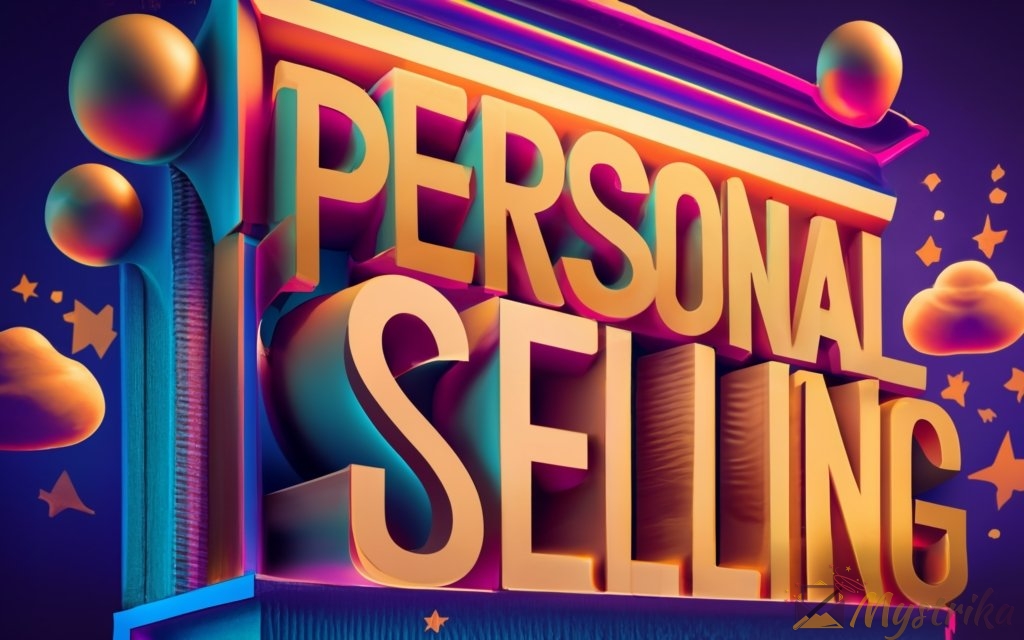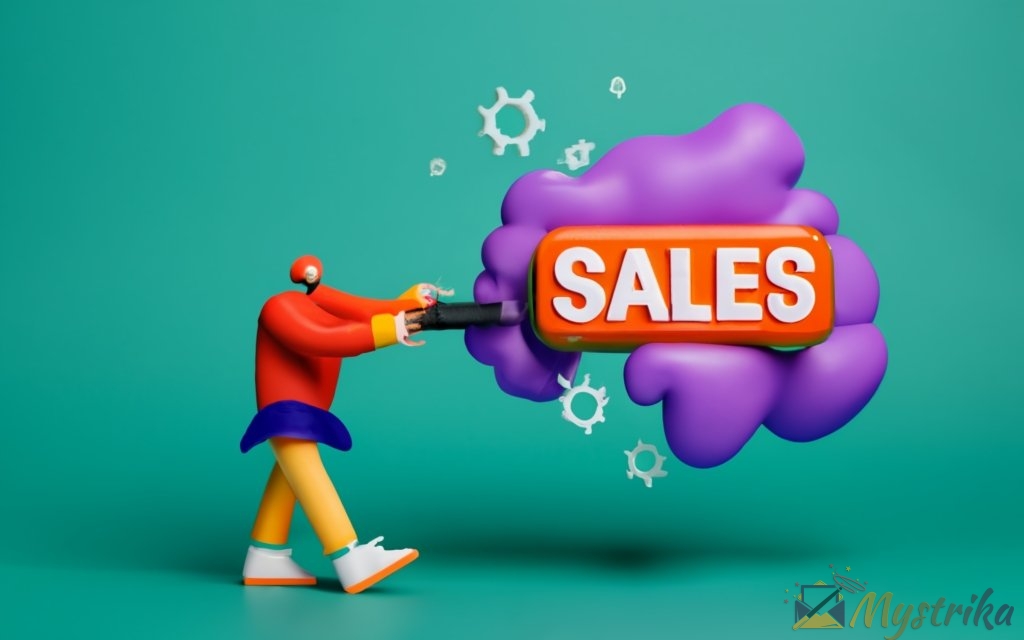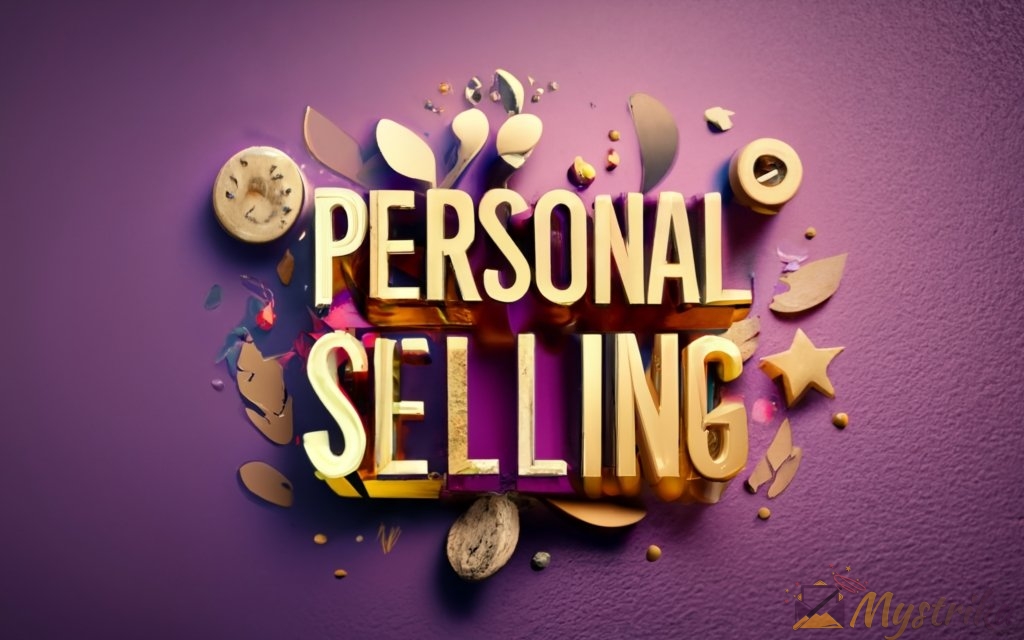Personal selling gets a bad rap sometimes. Stereotypes of pushy, annoying salespeople persist. Some see it as a dying form of marketing rendered obsolete by digital self-service and automation. But as humans, we intrinsically crave personal connections and expertise. That’s why personal selling not only survives but thrives into the future – when done right.
This comprehensive guide dispels myths about personal selling. It reveals the immense value uniquely human sales conversations deliver for both customers and businesses. Read on to learn proven personal selling strategies and competencies to master in the modern buyer’s journey. The human touch remains an irreplaceable competitive advantage.
What is Personal Selling?
Definition and Overview of Personal Selling
Personal selling is a promotional method that involves direct communication between sales representatives and potential customers. It’s a personalized approach focused on understanding customers’ needs and building relationships.
In essence, personal selling is about forming connections. Rather than blasting out generic ads, sales reps interact one-on-one with leads. They tailor their pitches, answer questions, and provide information specific to each prospect. Their goal is to educate, advise, persuade, and ultimately convert leads into buyers.
Some key characteristics of personal selling:
- Person-to-person communication: There’s face-to-face, voice-to-voice, or screen-to-screen interaction between the sales rep and lead.
- Customized sales presentations: Sales reps alter their messaging and product recommendations based on each customer’s unique needs.
- Relationship building: Developing rapport and trust with leads over time is a priority.
- Product education: Sales reps inform customers on product features, benefits, and value propositions.
- Question answering: Reps address any objections or concerns from leads directly and in real-time.
- Feedback gathering: Conversations allow reps to collect insights about prospects’ problems, desires, and preferences.
While personal selling often happens in person, advancements in technology have expanded options for remote selling via phone, email, social media, and live chat. The interpersonal dynamic remains central regardless of the medium.
Personal selling is commonly used in high-value, complex sales that require expertise and consultant-like guidance. Extensive interaction allows sales reps to steer customers towards the best solutions for them. It remains an indispensable sales strategy despite automation and digital disruption.
Evolution and History of Personal Selling
Personal selling has evolved substantially over the centuries, tracing its origins back to antiquity. Here’s a brief overview of the major eras:
- The Antecedents Era: Personal selling emerged in pre-modern times. Merchants bargained with customers at bazaars, fairs, and wholesale markets. Shopkeepers provided personalized service.
- The Emergence Era: The Industrial Revolution brought rapid manufacturing growth in the 1800s. Companies needed sales forces to sell inventory being mass-produced in factories. The first sales reps were often factory agents or distributors.
- The Golden Age of Selling: The early 20th century saw salesforces expand dramatically. New products like cars and appliances increased demand. Sales skills training became formalized, with an emphasis on relationship selling versus “pitch” selling.
- The New Profession Era: From the 1960s onwards, selling further professionalized. Large sales teams became the norm. Sales reps focused on consultative selling and solving customer problems. Relationship management software emerged.
Today, personal selling remains ubiquitous and essential in both B2B and B2C contexts. However, sales roles require digital fluency and emotional intelligence more than ever. Consultative, insight-driven selling is ideal. As technologies like AI enter the fray, the human touch remains personal selling’s core strength.
Personal Selling vs Other Sales Methods
Personal selling stands in contrast to transactional sales models that use broad promotional channels. Main differences include:
Personal Selling
- One-on-one communication
- Customized messaging and product recommendations
- Builds personal relationships and rapport
- Higher cost per customer acquisition
- Higher conversion rates and order values
- Complex, high-consideration purchases
Advertising
- Mass media broadcasts (TV, radio, online ads)
- Generic, less personalized messaging
- Lower customer acquisition cost
- Brand building over conversions
- Simple, low-consideration purchases
Direct Marketing
- Broadcast messages to buyer databases
- Some personalization at scale possible
- Response tracking capabilities
- Lower-effort sales cycle
- Mid-complexity consideration level
E-Commerce
- Self-service buying via web/mobile platforms
- Product-focused vs relationship-focused
- Low touch, high convenience model
- Low customer acquisition cost
- Routine reorders and simple purchases
Social Selling
- Loose integration of social media and sales
- Relationship building at scale
- Brand building and conversions
- Mid-complexity consideration level
In short, personal selling is the most high-touch, customized approach to sales. It thrives for big-ticket, complex solutions that require expertise and trust. While other models have their place, the human touch of personal selling remains unmatched when done right.

Types of Personal Selling
Personal selling comes in many shapes and sizes. Sales roles vary extensively based on factors like product, target customer, sales cycle, and more. Here are some of the most common forms of personal selling.
Direct Selling
Direct selling refers to person-to-person sales away from a fixed retail location. It often relies on direct seller networks and multi-level marketing structures. Some examples include:
In-Home Product Parties: The sales rep (often an independent contractor) conducts an in-home product party. They demonstrate and recommend products to the host and guests. Popular examples include Tupperware, Pampered Chef, and cosmetics companies like Mary Kay or Avon.
Independent Contractors: Businesses recruit networks of distributors, wholesalers, or sales agents to sell products. These independent reps receive commissions on sales and do much of the legwork of lead generation and customer management.
Multi-Level Marketing (MLM): Direct sellers recruit new distributors into their “downlines” and earn commissions on their sales. MLMs like Amway, Herbalife, or LuLaRoe use this model. However, MLMs are controversial, with many resembling pyramid schemes. Legitimate MLMs focus on selling products first and have buyback policies for inventory.
Direct selling commonly focuses on consumer packaged goods, cosmetics, wellness products, clothing, accessories, and home goods. Its personalized nature helps showcase products customers want to see, touch, or try on before buying. However, recruitment and retention challenges, as well as questionable MLM practices, plague parts of the industry.
Telemarketing
Telemarketing uses phones to connect sales reps with customers remotely. It rose to prominence in the 1960s and became maligned by the 1990s for unsolicited “cold calls.” Here are some telemarketing approaches:
Cold Calling: Sales reps call prospects from purchased lead lists with no prior relationship. Success depends on quick rapport building and value communication when interrupting people unannounced.
Warm Calling: Reps call leads with some prior brand awareness or expressed interest. Response rates improve over cold outreach.
Upselling: Calling existing customers to promote upgrades, cross-sells, and add-ons. Leverages an existing relationship.
Lead Generation: Calls qualify inbound leads and route them to appropriate sales reps.
Fundraising: Nonprofits solicit donations from supporters and members via phone drives.
Tele-surveys: Market research firms conduct surveys by phone.
While disruptive cold calling soured perceptions, telemarketing remains cost-efficient for qualifying leads at scale. Caller ID, do not call lists, and voicemail prompt adaptations like limited call blocks and voicemail dropping. As customer expectations evolve, integration with digital and personalized relationships marketing sharpens telemarketing success.
Door-to-Door Selling
Door-to-door sales teams visit homes personally to demonstrate and sell products. Common product categories include:
- Household goods like cookware, cleaning supplies, or personal care items
- Home services like security systems, satellite TV, energy suppliers, or home repair
- Home improvement like windows, roofing, siding, solar panels, or HVAC upgrades
- Newspaper and magazine subscriptions
Door-to-door selling peaked in the 1950s-1970s but waned with more women entering the workforce. Safety and privacy concerns also sparked no-soliciting policies. However, in-person visits allow personalized product education and needs assessment impossible via mass advertising.
Sellers must quickly build rapport and trust while respectfully overcoming resistance. Demonstrations and free samples help. Many door-to-door reps are independent contractors with commission-based compensation. Strong vetting and oversight by the hired company ensures professional conduct.
Business-to-Business (B2B) Selling
B2B selling targets organizational clients versus individual consumers. Lengthy sales cycles sell high-ticket, complex products and services. Examples include:
Technology: Software, hardware, IT infrastructure, and digital platforms for enterprise. Account management is paramount post-sale.
Business services: HR platforms, marketing automation, CRM, accounting, legal services, and more for organizations.
Heavy equipment/machinery: Industrial equipment, machine tools, commercial vehicles, manufacturing machinery, and more with lengthy sales cycles.
Raw materials and components: Ingredients, chemicals, textiles, electronics components, industrial parts/supplies, metals, and more sold business to business.
Management consulting: Large management consulting firms sell strategic advice, operational improvement, technology implementation, and change management services.
B2B selling usually involves long sales cycles spanning multiple stakeholder discussions and consensus building. Sales reps position themselves as trusted advisors guiding clients to business solutions, not just transacting orders. Patience and insight into organizational decision-making are critical.

The Personal Selling Process
Converting leads into buyers involves navigating prospective customers through a series of sales stages. Let’s explore the typical steps in the personal selling process:
Prospecting
Prospecting involves researching, identifying, and qualifying potential customers. Sales reps use various tactics to discover prospects:
- Reviewing existing customer and prospect lists within the company’s CRM system
- Obtaining leads from trade shows, webinars, and events
- Gathering referrals from current customers and partners
- Purchasing third-party lead lists based on demographics, interests, and intent signals
- Leveraging LinkedIn Sales Navigator and social selling techniques
- Subscribing to lead enrichment tools for demographic and firmographic data appending
- Calling prospects from relevant industries and titles found through research
- Mining website traffic for visitors exhibiting defined lead behaviors
- Capturing inbound inquiries from marketing activities
Qualifying determines if prospects align with the ideal customer profile (ICP) based on need, budget, authority, and timeline. Qualified leads pass to the sales development stage while unqualified leads circle back for further nurturing by marketing.
Pre-Approach and Approach
The pre-approach prepares the groundwork for an effective sales call. Sales reps:
- Research prospects using LinkedIn, company websites, news mentions, and social media
- Identify pain points and needs from public information
- Segment and personalize outreach strategies for key prospect groups
- Craft value propositions tailored to each prospect’s role and priorities
- Coordinate sales call timing based on trends like fiscal schedules
The approach makes the initial outreach, often by email or cold call, to introduce the company and offering. Sales reps:
- Grab attention with subject lines demonstrating relevance
- Establish credibility by mentioning current customers from the same industry
- Convey value quickly and invite conversation
- Suggest next steps like scheduling a call, demo, or meeting
Simple cold outreach works occasionally for transactional sales. But for complex sales, a steady drip campaign across multiple channels over time is ideal to warm up prospects.
Presentation and Demonstration
Sales presentations educate prospects on the product or service. The presentation should revolve around the customer’s pains and needs identified earlier.
- Features vs. benefits: Explain how product capabilities deliver value. Align features to prospect needs and use cases.
- Compare with competitors: Demonstrate competitive differentiation and advantages. Use benchmark data.
- Social proof: Provide customer testimonials, reviews, and case studies relevant to the prospect’s industry and goals.
- Trial opportunities: Let prospects directly experience the offering via free trials, demos, or samples tailored to their use case.
- Visuals: Use decks, one-pagers, videos, sample reports, and infographics to showcase value clearly.
- Q&A: Pause for open-ended questions and objections. Listen closely.
Virtual presentations using screen sharing, live demos, and interactive e-docs make distance sales possible. Send presentation summaries and resources to cement concepts.
Overcoming Objections
Objections reveal prospects’ inherent concerns. Sales reps should welcome objections as opportunities versus threats.
Common techniques to overcome objections include:
- Listen fully: Let prospects voice concerns. Rephrase to confirm understanding.
- Empathize: Acknowledge the rationality of objections given prospects’ vantage points.
- Isolate: Determine if the concern stems from personal priorities, company norms, or faulty assumptions.
- Clarify: Ask questions and provide information to correct misperceptions. Share facts and data.
- Refocus: Shift attention back to main needs and value propositions.
- Follow up: Promise action that addresses concerns raised.
Getting past objections builds credibility. But know when to walk away from deals poorly aligned with the solution.
Closing the Sale
Closing converts qualified, committed prospects into paying customers. Sales reps:
- Summarize agreements: Recap areas of aligned vision, needs, and value during discussions.
- Propose clear next steps: Request the sale, contract signing, or concrete follow-up actions progressing the deal.
- Provide options: Offer choices like trial periods, scaled packages, or flexible payment terms to close fence sitters.
- Highlight benefits: Emphasize how the solution addresses prospects’ objectives, pains, and challenges one last time.
- Create urgency: Note time-sensitive incentives like discounts expiring soon. Outline risks of delaying.
- Ask questions: “Do you have any other concerns before getting started?” Uncovers final barriers to close.
- Stop talking: After the ask, be silent and let prospects respond. Don’t interrupt their thinking.
Avoid scripted, high-pressure tactics. Consultative sales focuses on mutual value realization. Still, modest urgency prompts action.
Follow-Up and Maintenance
Follow-up continues nurturing deals to completion while laying groundwork for repeat sales.
- Set implementation plan: Coordinate equipment delivery, integration, training, data migration, and rollout schedule. Guide customer-success team handoff.
- Ensure adoption: Check in periodically on usage, challenges, and outcomes. Resolve friction and satisfaction gaps. Share best practices.
- Request referrals: Ask happy clients for testimonials, reviews, and referrals to their networks to stimulate viral growth.
- Upsell and expand: Discuss upgrades, additional modules, premium tiers, and expanded use cases.
- Renew and retain: Before contract expiration, highlight continued value and negotiate renewal. Retaining customers costs less than attracting new ones.
- Manage churn risks: Watch for usage declines and reduced engagement as potential precursors to non-renewal. Intervene promptly.
Ongoing education, outreach, and account management maximize customer lifetime value long after initial sale closure. The trusted advisor relationship extends across the entire customer journey.

Skills and Qualities of Successful Salespeople
What separates stellar sales reps from the average? While sales aptitude varies by personality, top performers share several common traits:
Communication Skills
Master communicators connect with prospects skillfully:
- Verbal dexterity: Articulate complex ideas clearly. Display confidence using industry terminology. Answer questions thoughtfully.
- Concise messaging: Summarize value propositions succinctly. Don’t ramble.
- Audience alignment: Adapt vocabulary, style, and tone for each audience. Balance professionalism and friendliness. Mirror prospect language.
- Storytelling: Communicate engagingly. Paint before-and-after pictures with anecdotes and analogies.
- Presenting: Convey ideas persuasively to groups. Create crisp, visually appealing slides.
- Writing: Craft compelling emails, social media posts, and collateral. Excellent grammar, structure, and editing.
- Non-verbal cues: Make eye contact, smile, face prospects, and use open gestures. Align body language with words.
- Media fluency: Choose the right communication channels and formats for each purpose and prospect. Blend digital with personal interactions.
Great communicators inspire audiences consistently. Hone these skills through practice, coaching, and learning from mentors.
Listening Skills
Communication is a two-way street. Superior listening allows personal connections:
- Focused attention: Listen without distractions and mental filtering. Be present and engaged.
- Comprehension: Grasp in-depth what is spoken, particularly emotions, subtle cues, and nuances.
- Open-ended questioning: Ask “what,” “how,” and “why” questions to uncover needs, goals, and concerns. Dig deeper with follow-up probing.
- Paraphrasing: Rephrase key points to confirm understanding. Summarize long responses concisely.
- Notetaking: Jot down important details. Revisit notes to identify themes and next steps. Ask permission first.
- Non-verbal cues: Notice prospects’ body language, facial expressions, and tone. Are they engaged, angry, or confused?
- Patience: Let prospects speak without interrupting. Don’t jump in with rebuttals.
- Empathy: Hear what isn’t said. Imagine being in the prospects’ shoes. Validate emotions.
Active listening builds rapport and trust. It’s an underappreciated skill. Hearing prospects’ contexts allows personalized solutions.
Product/Industry Knowledge
Sales reps must be subject matter experts on their solutions:
- Features and capabilities: Understand functionality, integrations, configurations and use cases inside-out.
- Value propositions: Articulate credible benefits and outcomes for different customer profiles.
- Competitive intelligence: Know competitors’ strengths, weaknesses, and points of differentiation deeply.
- Industry trends: Stay on top of market forces, disruptions, regulations, and innovations.
- Common challenges: Grasp typical customer pain points and needs in the industry.
- User workflows: Learn how clients utilize products day-to-day within business processes and systems.
- Pricing models: Explain pricing, packaging, and licensing options accurately. Calculate order values.
- Implementation: Familiarize with rollout, adoption, integration, and result measurement methodologies.
Ongoing education is essential as offerings evolve. Skilled reps translate technical details into compelling business value for customers.
Persuasion and Influence Skills
Persuasive communicators inspire action:
- Framing: Position messages in ways that resonate using prospect language patterns. Know each audience.
- Social proof: Cite credible facts, statistics, testimonials, and examples that provide credibility.
- Brevity: Be succinct. Make every word count. Avoid excessive jargon.
- Curiosity triggering: Pose interesting questions, novel views, or thought experiments that spark engagement.
- Emotion invoking: Tactfully invoke positive emotions of hope, pride, curiosity through stories.
- Call-to-action: Convert engagement into commitments to defined next steps. Clearly propose the action required.
- Responding to pushback: Defuse objections, skeptics, and conflicts calmly. Rebuild consensus.
Persuasion avoids manipulation or coercion. Skilled influencers enlighten audiences for win-win outcomes. They sell visions ethically with facts.
Relationship Building
Connecting personally cultivates sales success:
- Rapport building: Establish trust quickly through warmth, humor, and approachability. Find common ground.
- Network expanding: Continuously expand personal and professional networks. Leverage contacts.
- Referral seeking: Earn referrals by delighting customers with outstanding service.
- Follow-through: Do what you promise, when promised. Follow-up until completion.
- Loyalty: Support customers long-term. Their success leads to your success.
- Cultural attunement: Respect and accommodate different personalities, work styles, hierarchies, and values.
- Account planning: Strategically manage key accounts. Understand their businesses in-depth.
- Team selling: Coordinate seamlessly with colleagues across departments to orchestrate unified relationships.
Nurturing relationships for the long haul wins. Transactional interactions always underdeliver. Put people first.
Adaptability and Resilience
Selling requires embracing ambiguity:
- Flexibility: Adjust strategies smoothly based on new inputs. Pivot gracefully. Modify personal styles.
- Creative problem-solving: Improvise solutions when the script fails. Overcome obstacles with innovative thinking.
- Tech savviness: Continuously learn new sales productivity and automation tools. Use data.
- Self-monitoring: Assess your performance accurately. Seek constructive feedback.
- Grit: Persist through rejections, disappointments, and tough markets. Have a thick skin. View setbacks as growth.
- Balancing drive and patience: Be hungry and ambitious but also tolerant of long sales cycles. Avoid desperation.
- Self-care: Manage stress and energy proactively for sustainable peak performance. Stay positive.
- Lifelong learning mindset: Continuously invest in self-improvement. Read, get coaches, and find mentors.
Selling evolves quickly. Reps who stay nimble, optimistic, and growth-oriented will thrive through disruptions. Assess gaps objectively and address them.

Examples of Personal Selling
Personal selling permeates industries. While execution and product nuances vary, core selling principles remain constant. Let’s explore archetypes.
Retail Sales Associates
Retail sales reps assist shoppers in stores. Responsibilities include:
- Greeting customers entering the store warmly
- Explaining product features and benefits
- Demonstrating product usage
- Advising on purchase options for different needs
- Upselling additional items that complement main purchases
- Overcoming pricing objections with value messaging
- Processing transactions at checkout
- Following up on purchases via email and surveys
- Managing merchandise inventory and presentation
- Providing excellent customer service pre- and post-transaction
Traits like patience, friendliness, honesty and product passion excel in retail. Sales associates build personal customer relationships beyond one-off transactions. They strive to provide memorable experiences and become trusted advisors.
Many associates work on commissions, so sales skills directly impact their incomes. Strong visual merchandising, store traffic analysis, and conversion rate optimization skills help maximize sales. Omnichannel capabilities like order online, pickup in-store expand retail selling.
Car Salespeople
Car sales reps help buyers choose vehicles:
- Building rapport quickly during walk-ins, warm chats while test driving, and casual small talk
- Asking questions to understand customer needs – budget, usage, priorities
- Tailoring recommendations based on needs analysis – family, luxury, off-roading
- Demonstrating and test driving relevant models
- Explaining details like mileage, cargo space, technology, safety ratings
- Detailing pricing and financing options transparently
- Handling objections and reluctant buyers gently via incentives
- Guiding customers through purchase paperwork
- Arranging future servicing and maintenance packages
- Following up for reviews, referrals and repeat/upgrade purchases
Salespeople overcome pushy stereotypes by becoming trusted advisors. They educate customers, not pressure them. Emotional intelligence and reading body language helps navigate negotiations. Car sales remains a relationship-driven business requiring consultative guidance.
Real Estate Agents
Real estate agents connect home buyers and sellers:
- Assessing clients’ needs and budgets for their ideal properties
- Researching local markets deeply to match clients and homes
- Listing and marketing homes for sale through staging, photography and tours
- Advertising homes through MLS listings, digital and print campaigns
- Qualifying buyer leads from marketing and referrals
- Showcasing homes to prospective buyers via tours and open houses
- Negotiating purchase agreements and prices between parties
- Overseeing home inspections, appraisals, financing and closings
- Maintaining consistent communication throughout the lengthy process
- Follow-up marketing to past clients for repeat business
Estate selling combines sales skills with extensive property and market expertise. Agents must network continuously to generate new leads and referrals. Keeping clients engaged throughout months-long transactions tests patience and tenacity. But ideal matches create joyful outcomes.
Insurance Agents
Insurance agents educate and sell policies:
- Conducting needs assessments – life stage, assets, medical history, risks
- Explaining insurance plans and coverages for needs identified
- Comparing pricing and features of relevant provider policies
- Advising on appropriate coverage levels and ideal mixes
- Overcoming reluctance and mistrust – insurance is pushed, not sold
- Handling underwriting paperwork
- Coordinating application and enrollment logistics
- Servicing ongoing policy needs – claims, billing, changes, renewals
- Upselling and cross-selling additional policies at renewal
- Retaining customers long-term through consistent care
This type of selling fights perceptions of pushy sales and complex policies. Agents that simplify education and focus on protecting customers gain trust. They sell peace of mind amid life’s unpredictability.
Business Development Roles (B2B)
Business development reps sell products and services to other companies. Responsibilities include:
- Researching target accounts and contacts on LinkedIn, company databases, etc.
- Specializing in specific industries, product lines or geographies
- Running inbound and outbound campaigns – email, calls, events, social media
- Qualifying leads for sales readiness based on authority, need, budget
- Producing personalized email outreach sequences for key accounts
- Scheduling sales calls and discovery meetings with stakeholders
- Conducting remote demos and presentations for groups
- Answering RFPs/RFIs by conveying value propositions and differentiation
- Building consensus across buyer committees delicately
- Coordinating proposal and procurement processes patiently
- Consulting strategically on optimal solutions for client challenges
- Developing long-term, trusted advisor relationships across accounts
- Forecasting and reporting on pipeline growth and conversion metrics
B2B selling requires technical aptitude, organizational savvy, and perseverance. Complex sales cycle navigation separates average from stellar BDRs. Mastering sales technology and processes boosts productivity.

Benefits of Personal Selling
Despite myths that personal selling is passé, human interactions deliver immense value. Benefits include:
Deliver Customized Customer Experiences
Personal selling conversations uncover nuances impossible to gather through mass interactions. Sales reps tailor discussions and recommendations to match each customer’s unique needs and contexts.
- Ask probing questions to deeply understand customer challenges, workflows, and environments. Mass marketing lacks this depth.
- Recommend specific product configurations, integrations, and servicing options based on use cases.
- Guide customers through complexity with tailored advice – offline support impossible at scale.
- Resolve questions and objections instantly that generic content cannot address.
- Delight customers with personalized experiences that exceed expectations.
Customization requires sales proficiency and creative thinking. But it cements satisfaction and loyalty. Customers value partners invested in their success.
Build Relationships and Loyalty
Personal connections build rapport and trust that transactional interactions lack.
- Human conversations reveal shared interests, values, and purposes beyond business.
- Ongoing dialogue strengthens familiarity and comfort over time. Reps become trusted advisors.
- Discussing non-sales topics like family, hobbies, or sports helps relationships feel authentic, not forced.
- Following through reliably on promises and concerns discussed earns customer confidence.
- Sincere interest in helping customers achieve goals cements loyalty beyond a single sales transaction.
- Relationships based on candor and care inspire referrals and repeat sales.
Loyalty cannot be encoded into a website or automated. It flows from human bonding. Skilled salespeople cherish relationships.
Educate and Advise Customers
Personal selling allows customized education unscalable through static content alone.
- Answer wide-ranging customer questions in real-time during conversations.
- Share tips and best practices tailored to customers’ precise needs.
- Recommend configurations, integrations, and usage strategies based on workflows.
- Provide ongoing value-adds like free training resources, upgrades, and content.
- Proactively advise customers on optimizations and new capabilities as products evolve.
- Become trusted advisors guiding customers through complex purchasing decisions.
- Build awareness and understanding of new innovations difficult to grasp from specs alone.
Education establishes credibility. Customers follow advice from experts focused on their success.
Upsell and Cross-sell
Human conversations naturally uncover expansion opportunities missed by arms-length selling.
- Discuss overall business objectives during sales dialogue to expose latent needs.
- Make thoughtful suggestions on additional products/services benefiting customers.
- Remind customers of neglected capabilities already available to them to spur adoption.
- Propose upgrades or higher tiers that improve customers’ outcomes.
- Highlight integration opportunities with complementary partner solutions.
- Guide customers through bundling options and packages providing greater value.
- Review contracts and renewals to identify expansion possibilities.
Upsells must provide true value, not pressure buyers. When done right, customers appreciate personalized expansion recommendations from trusted advisors.
Gather Customer Insights and Feedback
Personal selling supplies qualitative insights difficult to extract at scale.
- Provide an open forum for customers to share their experiences candidly.
- Ask engaging questions during conversations to gain suggestions.
- Probe on difficulties, pain points, and desired improvements.
- Gather rich feedback on new releases and features from engaged users.
- Capture emotional, nuanced impressions impossible to glean from surveys and data alone.
- Gain early warnings of satisfaction issues and churn risks that metrics miss.
- Turn individual conversations into patterns revealing broader customer needs.
Customer insights, when shared internally, focus improvements and innovation. But insights require engaged listening first.

Challenges of Personal Selling
Personal selling is high-touch by nature. But the human element poses challenges including:
Requires Extensive Training
Mastery demands extensive skill building. Consider:
- Sales process, methodology, tools, and systems training.
- Product capability and industry domain training.
- Objection handling, negotiation, and closing skills development.
- Customer needs analysis and questioning techniques.
- Presentation, communication, and active listening skills.
- Relationship selling mindsets and emotional intelligence.
- Ongoing training as products evolve.
Comprehensive training is resource-intensive yet essential. Untrained reps struggle. Roleplaying and apprenticeships accelerate skills. But poor selling reflects badly on brands. Invest in talent.
Difficult to Scale and Automate
Human interactions are nuanced and contextual. Key challenges in scaling personalized selling include:
- Limited selling hours in the day constrains reps’ bandwidth.
- Increasing sales team size impacts culture fit and consistency.
- Lengthy sales cycles limit volume a rep can handle.
- Custom conversations resist automation and scripting.
- Buyer emotions and unspoken cues are tough to standardize.
- Holistic relationship building takes time and consistency.
- Individual judgment is required for situational nuance.
While analytics and AI assist, selling still requires human competency applied case-by-case. There are no shortcuts. Accept selling’s intrinsically high-touch nature.
Performance Fluctuations Between Reps
Sales aptitude and work ethic vary individually. Management struggles include:
- Hiring selectivity is challenging at scale. Screen for competency and drive.
- Incentives and compensation impact motivation levels.
- Ongoing micromanagement is hard across distributed teams.
- Underperformers damage customer experiences before identification.
- Turnover requires frequent hiring and onboarding.
- Keeping top talent engaged as they expand skills.
- Preventing burnout and overwork during growth spurts.
Optimizing team composition, morale, and productivity takes work. Balance technology efficiency with human nurturing.
Requires Significant Time Investment
Personal selling is labor intensive:
- Lead generation and prospecting takes extensive hours.
- Discussions and relationship building cannot be rushed.
- Following up and managing account hygiene is constant.
- Time zones constrain connections with global prospects.
- Sales cycles with long close horizons demand persistence.
- Post-sale relationship management continues indefinitely.
While sales technology assists, human touch remains time-intensive. Eliminate low-value time sinks, but avoid rushing authentic customer engagements.
Potential for Unethical Selling Practices
Professionalism is imperative to avoid:
- High-pressure product pushing rather than customer education
- Misrepresenting capabilities, benefits, pricing, or other details
- Not disclosing hidden fees, gotchas, and caveats
- Enrolling customers in services they don’t need
- Promising deliverables the company cannot meet
- Neglecting customers post-sale after securing contracts
- Poaching competitive accounts unethically
Avoid short-term optimization that damages long-term customer experiences. Transparency and integrity nurture sustainable success.
Unethical sales destroys trust. Prioritize customer advocacy over sales quotas. Foster healthy, ethical sales cultures.

Best Practices for Effective Personal Selling
How can organizations optimize personal selling success? Key best practices include:
Provide Ongoing Sales Training
Continuous skills development is imperative:
- Explain sales methodology, processes, and tools thoroughly during onboarding. Ensure comprehension through testing.
- Conduct regular product and industry training workshops to sharpen reps’ domain expertise.
- Invest in advanced negotiation, objection handling, and closing skills courses. Practice techniques through roleplaying.
- Send top reps to specialized sales skills seminars and conferences to bring back insights.
- Arrange mentorships and apprenticeships for junior reps to learn from veterans.
- Monitor calls and provide individualized coaching and feedback to improve.
- Foster a growth mindset culture via reading, e-learning, book clubs, and discussion groups.
- Share customer engagement best practices through a sales knowledge management portal.
- Standardize onboarding and skills development with sales enablement technology.
Skills erode rapidly without exercise. Maintain a robust training curriculum blending formal and informal learning.
Set Clear Goals and Performance Metrics
Align activities with outcomes using:
- Define key performance indicators for essential sales results – calls, deals closed, revenue, etc.
- Breakdown targets by rep. Consider specializations, tenures, and territories.
- Set standards for important activities like calls per day, referral requests, and touchpoints per prospect.
- Track lead response times, sales cycle length, and customer retention metrics.
- Generate leaderboards and sales contests to gamify skill building.
- Review progress transparently in 1:1s and team meetings. Identify gaps.
- Reward top performers publicly. Have underperformers shadow them.
- Adjust goals based on market conditions, seasonal trends, and product changes.
What’s measured improves. Metrics provide focus, accountability, and motivation.
Leverage CRM and Sales Enablement Tools
Technologies streamline selling:
- Centralize prospect/account data in CRM systems saleswide. Keep organized and accessible.
- Build targeted prospecting lists for call campaigns within CRMs.
- Automate lead scoring and routing rules based on behaviors and profiles.
- Template common playbooks, email outreach campaigns, and collateral to ensure consistency.
- Store winning proposals in databases for easy reuse and modification.
- Share approved presentation decks, product one-pagers, case studies and other sales assets.
- Automate customer lifecycle marketing and reminders triggered by milestones.
- Integrate tools into reps’ workflows through single sign-on consoles. Minimize task switching.
Technology eliminates drudgery so reps can focus on high-value selling. Simplify their work.
Motivate and Incentivize Sales Teams
Engaged reps perform better:
- Compensate competitively with base salaries, uncapped commissions, equity, and bonuses.
- Recognize top performers publicly through awards, praise, and promotions.
- Enable flexible schedules and remote work options to support work-life balance.
- Foster team camaraderie through offsite outings, events, and friendly competitions.
- Gather ongoing feedback to incrementally improve rep experiences.
- Promote positive, collaborative cultures vs individual competition.
- Share inspirational customer success stories. Make meaning and impact tangible.
- Offer development opportunities, career pathing, and leadership mentoring.
- Intervene with underperformers through supportive coaching, not punishment.
Purpose-driven, high-morale sales teams thrive. Sustain mental health and prevent burnout.
Build a Customer-Focused Sales Culture
Ethical practices earn trust:
- Hire reps motivated by customer advocacy, not self-gain. Screen for empathy.
- Train reps to educate, guide, and advise – not manipulate prospects.
- Emphasize long-term relationships and lifetime value – not one-time sales.
- Discourage unethical behaviors strictly. Never pressure or mislead customers.
- Institute controls preventing misconduct – scripts, recorded calls, etc.
- Solicit customer feedback about interactions. Address concerns promptly.
- Let customers depart freely if uninterested. Never harass.
- Share feedback internally to continually improve customer experiences.
- Publicly recognize reps delivering outstanding customer experiences.
Customer-centric cultures drive sustainable success. Never sacrifice integrity for sales.

The Future of Personal Selling
How will personal selling evolve in the digital age? Key trends shaping its future include:
Omnichannel Sales Experiences
Sales interactions will seamlessly blend digital and physical channels:
- Prospects engage on websites, then switch to emails, social messages, phone calls, video conferences, in-person meetings, and more.
- Reps interact on prospects’ preferred platforms, integrating tools into a unified experience.
- Showroom product demonstrations integrate with virtual try-ons and augmented reality.
- Appointments pivot smoothly between video, chat, and in-person as needed.
- CRM data stays consistent across channels through mobility and integration.
- Analytics track omnichannel customer journeys for optimization.
- Automation coordinates follow-ups across channels triggered by prospect actions.
The future adapts selling to customers’ channel-hopping behaviors. Linked physical and digital relationship building will become the norm.
Virtual Selling and Remote Workforces
Mobile digital selling will expand:
- Video meetings replace physical visits through platforms like Zoom, WebEx, and Skype.
- Collaboration apps enable content sharing, screen peering, and workflows.
- AI meeting assistants schedule meetings automatically.
- Sales reps work flexibly from home, shared offices, and onsite with clients.
- BYOD mobility and unified clouds enable productivity anywhere with single sign-on.
- Digital asset management provides on-demand access to latest collateral.
- Sales training gamifies learning through apps, simulations, and VR.
- Analytics harness data from email, calls, video chats, and social media.
- Culture reflects values and mindsets appropriate for distributed teams.
Technology removes geography as a sales limitation. Virtual selling broadens talent pools and work-life flexibility.
Automation and AI for Improved Efficiency
Emerging technologies will amplify human productivity:
- Leads get qualified automatically based on behaviors, profiles, and machine learning.
- Intelligent assistants schedule meetings via natural language conversations.
- Call analysis discerns emotions, keywords, and trends to refine messaging.
- Analytics prescribe ideal next actions during sales based on past wins.
- Chatbots answer common questions to offload simple inquiries.
- Documents get populated automatically with customer data and intelligence.
- Administrative tasks like data entry and reporting become automated.
- Predictive analytics identify at-risk accounts for early intervention.
- Lifecycle marketing triggers personalized, timed outreach automatically.
Automation handles high-volume drudgery so reps focus on high-value selling. AI augments human judgment.
Focus on Consultative and Advisory Roles
Selling will shift from transactions to business transformations:
- Reps become trusted advisors guiding customers through change, not just salespeople.
- Business reviews analyze entire customer lifecycles holistically beyond deals.
- Conversations focus on long-term business impact versus features.
- Reps proactively suggest improvements vs waiting for inbound issues.
- Success plans outline transformation roadmaps, not just adoption.
- Expansion identifies new business opportunities vs simple upsells.
- Teams integrate internally across departments to orchestrate consultative partnerships.
Consultative relationships enable mutual growth beyond one-off sales events. Shared purpose drives lasting partnerships.
Data-Driven Personalization and Customization
Rich analytics will customize engagements:
- Unified customer data provides 360-degree perspectives saleswide.
- Metrics highlight usage patterns, workflows, and pain points for tailored advice per account.
- Predictive analytics flag customer needs proactively before they request help.
- Lifecycle stage triggers appropriate messaging for each phase.
- AI assistants recommend configurations and optionality tailored to each customer during conversations.
- Customer language patterns inform unique styles and vocabularies for each rep-buyer relationship.
- Testing refines outreach content and swag for ideal personalization.
- Outbound campaigns feature dynamic content using CRM integration.
- Engagement data guides human judgment, not replaces it.
Customization powered by data science maximizes relevance. But relationships remain human-driven.
The future of selling remains brightly human. With enabling technologies, personal selling will evolve to elevate customers further through trust and insight.

Key Takeaways on Personal Selling
- Personal selling involves personalized, consultative communication between sales reps and prospects. It focuses on building relationships and meeting unique needs.
- Personal selling shines for complex, high-value purchases requiring expertise. It allows tailored education, advice, and custom solutions impossible at scale.
- Various personal selling types exist, from retail associates toinsurance agents. But core competencies like communication skills, product knowledge, and relationship building apply across roles.
- An in-depth sales process underpins success. Steps include prospecting, presenting, handling objections, closing, and account management.
- Skills like emotional intelligence, listening, problem solving, and resilience characterize top sales professionals. Mastery takes continual training.
- Benefits include personalized experiences, loyalty, education, expansion sales, and customer insights impossible via self-service.
- Challenges range from training needs to unethical practices. Mitigations include culture building, goal setting, and sales enablement technology.
- Best practices span training, performance tracking, motivating teams, optimizing processes, and prioritizing customer advocacy.
- The future points to omnichannel sales capabilities, virtual workforces, analytics-driven customization, automation, and consultative partnerships.
- Yet for all technologies may improve, the human touch remains integral to selling done right. Personal connections drive results.
Personal selling retains central importance in the digital age by providing human relationships, expertise, and adaptation difficult to automate. Mastering both art and science makes sales professionals more valuable than ever.
Frequently Asked Questions About Personal Selling
What is personal selling?
Personal selling is a promotional method that involves personalized, consultative communication between a salesperson and prospect. It focuses on understanding needs, solving problems, building relationships, and customizing solutions.
What are the main types of personal selling?
Major personal selling approaches include retail sales, door-to-door selling, telemarketing, insurance sales, automotive sales, real estate sales, financial services sales, pharmaceutical sales, and business-to-business sales.
What skills make a good salesperson?
Top salespeople excel at communication, emotional intelligence, listening, problem-solving, relationship-building, product expertise, persuasiveness, resilience, adaptability, and managing ambiguity.
What are the main steps in the sales process?
The key stages in the sales process are prospecting, pre-approach, approach, needs assessment, presentation, overcoming objections, closing, and follow-up account management.
What are the main benefits of personal selling?
Benefits of personal selling include customized solutions, relationship-building, loyalty, personalized education, expansion sales via upsells/cross-sells, gathering insights and feedback, and high-touch service.
What are some challenges with personal selling?
Challenges of personal selling include extensive training requirements, difficulty scaling, performance inconsistencies, time-intensiveness, unethical practices, and fluctuating sales.
How is personal selling evolving in the digital age?
Personal selling is evolving to blend physical, digital, and virtual channels while leveraging automation, data, and AI to enhance human productivity and relationships.
How can you optimize personal selling success?
Best practices to optimize personal selling include training, goal-setting, sales enablement technology, collaboration, specialization, customer-centric culture building, and ethical relationship focus.
What separates average salespeople from top performers?
Top sales professionals differentiate themselves by strong communication abilities, emotional intelligence, problem-solving skills, resilience, self-improvement focus, customer orientation, and relationship-building.

